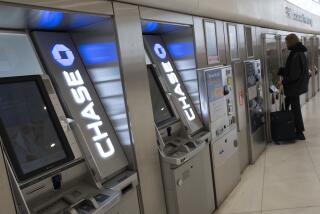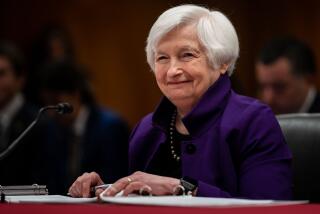FDIC to Drastically Reduce Deposit Insurance Premiums Paid by Healthy Banks
- Share via
WASHINGTON — The nation’s healthy banks could save up to $4.4 billion annually in premiums for deposit insurance under a drastically reduced rate structure approved Tuesday.
The Federal Deposit Insurance Corp. board, by a 4-0 vote, agreed to slash premiums banks pay into the insurance fund, a reduction that could go into effect by September.
The FDIC manages the fund, which insures deposits in member banks for up to $100,000 per account in the event a bank fails. The fund was endangered in the early 1990s as plunging real estate prices led to thousands of bank failures.
Banks have since rebounded, and the fund is healthy enough that the FDIC said it can cut the premiums for healthy banks from 23 cents per $100 of deposits to 4 cents per $100. About 92% of the nation’s banks will pay the lower rate.
The weakest banks will continue to pay 31 cents per $100 of deposits, a premium aimed at encouraging management to improve balance sheets in order to cut the insurance costs.
FDIC Chairman Ricki Tigert Helfer said that when the new rates go into effect, commercial banks are expected to save $4.4 billion annually, which could increase banks’ after-tax profits by $3 billion.
She said the new rate schedule “is a reflection of the strength of the industry, the strength of the Bank Insurance Fund and the commitment of the FDIC to reward well-run institutions and give weaker institutions an incentive to improve.”
The rates will not go into effect until the FDIC has certified that the insurance fund has met its target level of $1.25 per every $100 of insured deposits. The agency said it believes the fund reached that level in the second quarter, but it will not know for sure until it finishes analyzing bank financial reports for the period, in September.
The lower payments will be retroactive until May or June, and banks that overpaid into the fund will be given a one-time refund.
FDIC Vice Chairman Andrew Hove tried to persuade the board to cut premiums even further. He challenged estimates by the agency’s staff, saying the new rates may result in the banking industry paying too much money into the fund.
Helfer said the rules adopted Tuesday allow the FDIC to quickly lower or raise insurance premiums to coincide with forecasts of the banking industry’s health, expected bank failures and the economic outlook.
The board also voted to keep insurance premiums at the same level for the nation’s savings and loan associations--an average of 23.7 cents per $100 of deposits. S&Ls; will have higher payments because their insurance fund is on shaky ground; one large thrift failure could exhaust its resources, regulators have said.
The thrift insurance fund is suffering because of the declining number of S&Ls; and large debts left over from the massive thrift failures of the 1980s.
That disparity between the bank and thrift insurance payments is a major issue before Congress. Helfer and other bank regulators have proposed that the S&Ls; make a one-time payment of $6 billion to bring the thrift fund to its maximum level, then merge the bank and thrift funds.
More to Read
Sign up for Essential California
The most important California stories and recommendations in your inbox every morning.
You may occasionally receive promotional content from the Los Angeles Times.













